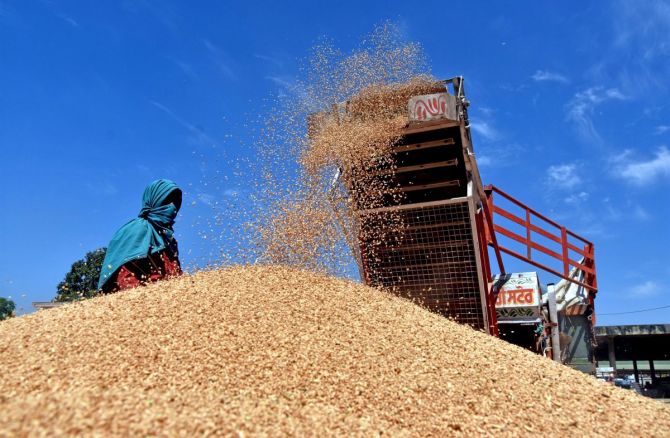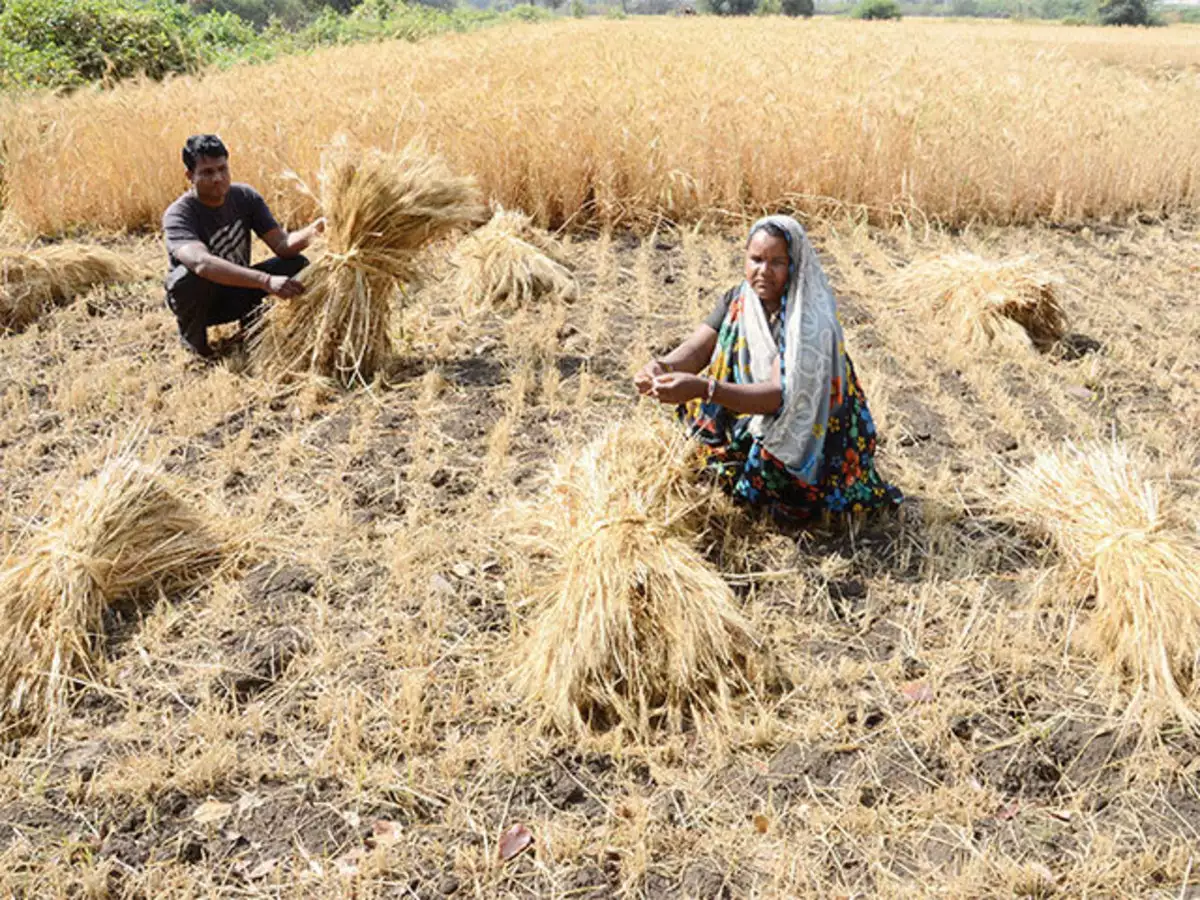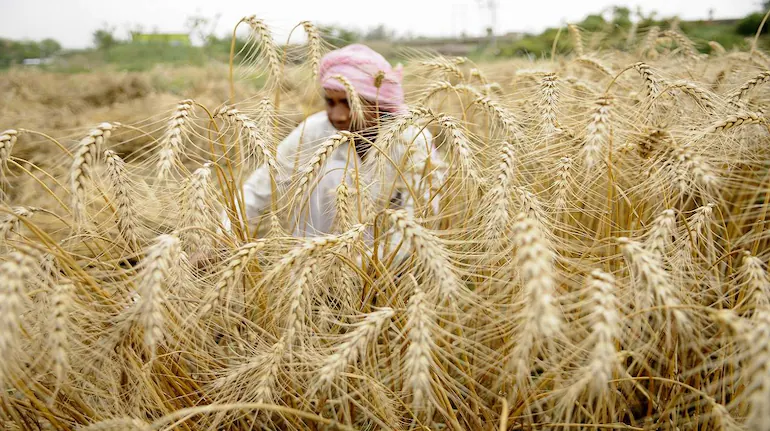India Bans Wheat Exports With Immediate Effect

India Bans Wheat Exports With Immediate Effect
According to an official announcement, India has banned wheat exports with immediate effect as part of measures to curb soaring domestic prices. However, export shipments for which irrevocable letters of credit (LoC) were issued on or before the date of this announcement will be approved, according to a May 13 notification from the Directorate General of Foreign Trade (DGFT).
The DGFT stated, “Wheat export policy is prohibited with immediate effect…”
It further stated that wheat exports would be permitted dependent on permission granted by the Indian government to other nations to meet their food security needs and on their governments’ requests. The DGFT announced the easing of export conditions for onion seeds in a separate announcement. “With immediate effect, the export policy of onion seeds has been placed in the restricted category,” it stated.
Onion seeds were previously prohibited from being exported.
According to official figures released this week, retail inflation hit an eight-year high in April due to high fuel and food prices.
The export prohibition comes as global wheat supplies are disrupted as a result of the ongoing conflict between Russia and Ukraine, two key wheat exporters.
Due to high worldwide demand, India’s wheat exports increased to 7 million tonnes worth USD 2.05 billion in 2021-22. According to DGFT data, approximately half of all wheat exports went to Bangladesh in the previous fiscal year. This year, the country exported roughly 963,000 tonnes of wheat, compared to 130,000 tonnes the year before.
In 2022-23, India aimed to export 10 million tonnes of wheat. India’s commerce ministry recently announced that trade delegations would visit Morocco, Tunisia, Indonesia, the Philippines, Thailand, Vietnam, Turkey, Algeria, and Lebanon to investigate ways to increase wheat shipments. Due to high loading by private traders and low arrivals in Punjab and Haryana, India’s wheat purchases fell drastically by 44% to 16.2 million tonnes as of May 1 in the current Rabi selling season.
In the last year, the government brought 28.8 million tonnes of wheat. From April to March, the rabi marketing season takes place. Due to increased demand for wheat for export, private parties have purchased wheat at a price higher than the minimum support price. The Centre has set a goal of procuring a record 44.4 million tonnes of wheat in the 2022-23 marketing year, up from a previous high of 43.34 million tonnes.
Due to fewer major pool purchases, the Centre has halted the sale of wheat to bulk customers under the Open Market Sale Program (OMSS) and advised them not to wait for the scheme to resume before purchasing the grain.
According to the agriculture ministry’s second advance estimate, wheat production will reach a new high of 111.32 million tonnes in the 2021-22 crop year (July-June).
The Wheat Sector in India: Production, Policies and Food Security

About Wheat
India’s main cereal crop is wheat. The country’s entire cropland area is over 29.8 million hectares. Wheat output has expanded dramatically in the country, from 75.81 million MT in 2006-07 to an all-time high of 94.88 million MT in 2011-12. Wheat productivity grew from 2602 kg/hectare in 2004-05 to 3140 kg/hectare in 2011-12. The states of Haryana, Punjab, and Uttar Pradesh have seen increases in wheat productivity. MP has experienced increased coverage in recent years.
Indian wheat is mostly a soft/medium-hard, medium protein white bread wheat, similar to hard white wheat in the United States. Hard wheat is grown in central and western India, with high protein and gluten content. India produces 1.0-1.2 million tonnes of durum wheat, the majority of which is grown in Madhya Pradesh. Due to market yard segregation issues, most Indian durum is not sold individually. However, the private trade purchases some quantities at a higher price, primarily for processing higher-value/branded products.
Wheat crop output and productivity were low when India gained independence in 1947. During 1950-51, wheat production was just 6.46 million tonnes, with a yield of only 663 kg per hectare, which was insufficient to feed the Indian population. Under PL-480, the country used to import large amounts of wheat from many nations, like the United States, to meet the requirements of our people. The reasons for Wheat’s low production and productivity at the time were:
Its tall growing plant habit, resulted in lodging when grown in fertile soils.
The varieties’ poor tillering and low sink capacity.
Higher susceptibility to diseases.
Higher sensitivity to thermo & photo variations, etc., resulting in poor adaptability.
Longer crop duration, which resulted in a long exposure of plants to climatic variations and insect pests.
In 1961, the Indian government established a panel to investigate the viability of boosting crop output under current Indian ecological conditions. The wheat situation in our country has entirely changed due to several initiatives taken by the Indian government. Our country used to import Wheat for our requirements after independence. Still, we became Wheat self-sufficient due to a massive rise in Wheat output and productivity during the ‘Green Revolution’ period in the late 1960s. At the moment, the country is producing far more Wheat than is needed, and godowns are overflowing.
Climate requirement
Wheat has a wide range of flexibility. It can be grown not only in tropical and subtropical zones but in temperate zones and frigid northern tracts, even over 60 degrees north latitude. Wheat can withstand extreme cold and snow and continue growth once the weather warms up in the spring. It may be grown everywhere from sea level to 3300 metres.
The best wheat is grown in places where the weather is cool and damp for the majority of the growing season, followed by dry, warm weather to allow the grain to ripen correctly. Wheat seeds grow best at temperatures between 20 and 25 degrees Celsius, while they can germinate at temperatures between 3.5 and 35 degrees Celsius. Rains soon after sowing inhibit germination and promote seedling blight. Wheat cannot be grown in areas with a hot and humid climate.
Wheat is harmed by excessively high or low temperatures and drought during the heading and flowering periods. Rust attack is aided by cloudy weather, high humidity, and cold temperatures. At the ripening time, the wheat plant requires an average temperature of 14-15 degrees Celsius. Temperature conditions during grain filling and development are very important for yield. During this time, temperatures above 250°C tend to reduce grain weight.
When temperatures are high, the plants lose too much energy through transpiration and the diminished remaining energy results in poor grain production and lower yields. Wheat is primarily grown in India during the rabi (winter) season.
Soil
Wheat is grown in India’s diverse soils. Wheat can be grown in soils with a clay loam or loam texture, good structure, and a moderate water holding capacity. Highly porous and overly drained oils should be avoided. The reaction of the soil should be neutral. Wheat cultivation in dry climates requires heavy soil with sufficient drainage. These soils are excellent at absorbing and retaining rainwater. Wheat is sensitive to waterlogging. Thus heavy soils with poor structure and drainage are not suited. Wheat can be cultivated successfully on lighter soils with enhanced water and nutrient storage capacity.
Fertiliser management
Another area where great success has been made is fertiliser timing and placement. It was found that optimum productivity required 120-kilogramme nitrogen, 60 kg phosphorus, and 30 kg potash per acre. The nitrogen was to be delivered in two divided doses of 60 kg as a basal dose and the remaining 60 kg at first irrigation, with total phosphorus and potash applied as a basal dose. New wheat types have recently reacted to up to 180 kg N/ha, with an optimal dose of around 150 kg/ha.
Zinc spraying at 25 kg/ha in a rice-wheat system was found to boost yield in the Indo-Gangetic plains significantly. Sulphur has recently been discovered to be effective for increasing wheat production and grain protein content. There has been a response to Mn (pockets in the Indo-Gangetic plains) and boron (eastern and far eastern region).
Nutrient management
The essential nutrient shortage has grown widespread as a result of intensive agriculture. According to research undertaken under the All India Coordinated Research Project on Micronutrients in Crops and Soils, zinc deficiency in soils is widespread in India. At the national level, micronutrient deficiency rates are 46 per cent for Zn, 17 per cent for B, 12 per cent for Mo, 11 per cent for Fe, and 5 per cent for Cu. The sulphur shortage has been documented in a wide range of soils (38 per cent ). More than 40 crops, including cereals, millets, oilseeds, and pulses, have had yield responses to sulphur.
• Site-specific nutrient management for targeted yields could be one strategy to realise the potential yield.
• Tillage techniques like FIRBS for boosting nutrient use efficiency
• Remote sensing for efficient nutrient management
• Nutrient management, straw quality in relation to human and animal health

Top 5 wheat-producing states in India: Facts and Figures
India’s economic development is mainly centred on agriculture. Humans began replicating food for their own consumption at first. They gradually began storing and commercialising the food.
Wheat is one of the most significant grains grown in the country, valued for its high fibre and carbohydrate content.
The top five wheat-producing states in India are as follows:
1. Uttar Pradesh :
UP is one of India’s top wheat-producing states. It is located in the Ganges River Basin, which is quite fertile.
Wheat production in the state reaches 300.010 lakh net tonnes. Wheat is farmed in the state on more than 96 lakh hectares of land.
Uttar Pradesh is a northern Indian state. It is India’s most populous state and the world’s most populous nation subdivision, with over 200 million people. It was founded after India became a republic in 1950. During the Dominion of India (1947–1950), it was a successor to the United Provinces (UP), which was a successor to the United Provinces created in 1935, and eventually of the United Provinces of Agra and Oudh established in 1902 during the British Raj.
The state is split into 18 divisions and 75 districts, with Lucknow serving as the state capital and Allahabad as the judicial capital. Uttaranchal (now Uttarakhand) was formed from Uttar Pradesh’s western Himalayan hill area on November 9, 2000. The state’s two major rivers, the Ganges and its tributary Yamuna meet at Allahabad’s Triveni Sangam, a Hindu pilgrimage destination. Gomti and Saryu are two other major rivers. The state’s forest cover covers 6.1% of the total land area. The cultivable area makes up 82 per cent of the general geographical area, while the net planted area makes up 68.5 per cent of the cultivable area.
2. Punjab:
Punjab is a northern Indian state. The state is bordered to the north and northeast by the Indian states of Himachal Pradesh, Haryana, and Rajasthan. The Indian union territories of Chandigarh and Jammu & Kashmir are to the south and southeast. It is part of the greater Punjab area of the Indian subcontinent. Punjab, a Pakistani province to the west, has an international boundary.
The state covers 50,362 square kilometres (19,445 square miles), or 1.53% of India’s total geographical area, making it the 19th-largest state in terms of area out of 28 Indian states (20th largest, if UTs are considered). Punjab is the 16th most populous state, with about 27 million people living in 23 districts.
It is the ideal place for agricultural operations because five rivers surround it.
The states have roughly 40 lakh hectares of land available for cultivation, with wheat being grown on more than 35 lakh hectares.
Wheat production in the state reaches 164.720 lakh net tonnes.
3. Haryana:
Haryana is an Indian state in the country’s northwestern region. On November 1, 1966, it was created out of the previous state of East Punjab on linguistic grounds. It occupies less than 1.4 per cent (44,212 km2 or 17,070 sq mi) of India’s land area, ranking 21st. The state capital is Chandigarh, which it shares with the neighbouring state of Punjab, while the most populated city in Faridabad is part of the National Capital Region.
Gurgaon is an important financial and technical centre in India. Haryana has 72 districts, 93 revenue tehsils, 50 sub-tehsils, 140 community development blocks, 154 cities and towns, 7,356 villages, and 6,222 village panchayats.
This state, which is located in the northern part of the country, is well-known for its large wheat production and consumption.
They cultivate 116.30 lakh net tonnes of wheat in the state, covering 25 lakh hectares.
4. Madhya Pradesh:
Madhya Pradesh is a central Indian state. Bhopal is the capital, and Indore is the largest city. Other notable cities include Jabalpur, Ujjain, Gwalior, and Satna. With nearly 72 million citizens, Madhya Pradesh is India’s second-largest state by area and fifth largest by population. It is bordered on the northeast by Uttar Pradesh, on the southeast by Chhattisgarh, on the south by Maharashtra, on the west by Gujarat, and on the northwest by Rajasthan.
It is one of the states in India that produces the most wheat.
Wheat production reached 76.271 lakh net tonnes. Shore, Hoshangabad, Vidisha, and other critical wheat-producing regions in MP include Shore, Hoshangabad, and others.
5. Rajasthan:
Rajasthan is a state in India’s northwestern region. It covers 342,239 square kilometres or 10.4% of the total land area of India. In terms of both land size and population, it is India’s largest state. It lies in India’s northwest region, covering the enormous and severe Thar Desert (also known as the Great Indian Desert), and shares the Sutlej-Indus River valley with Pakistan’s Punjab and Sindh provinces to the northwest and west, respectively.
Punjab borders it on the north, Haryana and Uttar Pradesh on the northeast, Madhya Pradesh on the southeast, and Gujarat on the southwest.
Even though a big part of the state is desert, it is one of the top five wheat-producing states in the country.
Every year, the state produces 72.145 lakh net tonnes of wheat. The state produces 8% of the total wheat grown in the country.

Does India have surplus wheat production? Which are the countries considering importing the foodgrain?
Despite being the world’s second-largest wheat producer, with 13.53 per cent of global wheat production, India’s wheat exports account for less than 1% of global totals. Each year, India produces approximately 107.59 million tonnes of wheat, the majority of which is consumed domestically. India is attempting to devise a new approach to fulfil rising global wheat demand, particularly from South Asian countries. Because of the ongoing war between Russia and Ukraine, India has gained a significant share of the global wheat trade.
If the war continues, wheat consumers may become more reliant on large exporters like India and China. In the context of rising oil prices, the strengthening of the dollar might be beneficial to Indian exporters. According to industry analysts, India will be able to fulfil the short-term increase in global wheat demand this year because it has excess supply. Currently, the country has about 100 million tonnes of wheat stored in its granaries. The country is forecast to produce 316 million tonnes of wheat in the two-year period 2020-21, a new high for the country.
In the past, India was not a major wheat exporter. The government has exported much non-basmati rice and wheat to foreign countries in the recent two years. Even if India has enough wheat to export, according to Madan Sabnavis, chief economist at the Bank of Baroda, the country lacks a long-term plan that would make it easy to export the product to other countries.
Over this time, exports increased by 527 per cent each year to 3.2 million tonnes, which is a massive increase. Due to predicted demand, India may export a record 7-8 million tonnes of wheat in fiscal year 22. In 2020-21, it sold 2.09 million tonnes of food grain.
Despite the fact that Asia Pacific countries do not import large volumes of food straight from Russia, the Philippines is the only one that does. After rice, wheat is the Philippines’ second-largest import from Russia. India can assist the Philippines, resulting in improved regional relations. According to the Indian Express, no response has been received to emails sent on Thursday to the ministries of Commerce and Industry, Agriculture and Farmers’ Welfare, and the Philippine embassy in New Delhi. This will put India in a better position than it now is.
In both volume and value terms, Bangladesh accounts for the great bulk of India’s wheat exports in 2020-21, accounting for more than 54 per cent of total wheat exports in both volume and value terms. According to the World Wheat Research Institute, India will join new wheat markets in 2020-21, including Yemen, Afghanistan, Qatar, and Indonesia, among others.
India’s wheat exports are projected to account for less than 1% of total global wheat exports. However, from 0.14 per cent in 2016 to 0.54 per cent in 2020, it has increased from the preceding year. India is second in the world in terms of overall wheat production, accounting for 13.53 per cent of total worldwide wheat production in 2013.
It produces roughly 107.59 million tonnes of wheat per year, with the majority of that being used for domestic consumption.
India’s grain exports have been steady so far this fiscal year, and if more orders come in, the country could wind up shipping unprecedented levels of wheat this fiscal year and early next year.

The price of India’s growing importance as a wheat exporter
With more wheat being exported to other parts of the world, India’s domestic prices rise.
India, the world’s second-largest producer of foodgrain, only accounted for 1% of worldwide exports until the Russia-Ukraine conflict erupted. Because of the war, it can now sell its excess wheat supplies.
Several countries have recently lined up for Indian wheat: Turkey just secured a 50,000-tonne order. Egypt, the world’s top buyer of Russian and Ukrainian wheat, authorised India as a new supplier a month ago, with plans to acquire a million tonnes.
Amid this uptick, production in India has dropped, mainly owing to solid heatwaves in March. The Indian government cut output projections for the crop year ending in June by 5.7 per cent to 105 million tonnes (MT) from a planned 111.32 MT on May 4.
Wheat prices in the country have risen dramatically by 15-20 per cent in recent weeks due to these reasons.
Wheat is a key staple foodgrain in India, second only to rice in terms of consumption. It’s also a common ingredient in foods like bread, biscuits, and rotis. When prices rise, consumers across the board feel the pain. It’s terrible news for a country where consumer food price inflation has already more than doubled since March 2021.
What’s next for wheat exports from India?
With Russia, the world’s largest wheat exporter, facing sanctions, India will become an even more vital alternate source of the foodgrain, mainly as crop quality improves.
“Previously, India was not recognised for its high-quality wheat, but now, thanks to new seed types, India’s wheat is as good as any high-quality wheat from other big global suppliers,” Gyanendra Pratap Singh, chief of the Indian Institute of Wheat and Barley Research, told Business Standard. Farming practices have improved, as have modern machines.
Farmers are ecstatic because selling to private traders rather than the state stockpiler is more profitable. However, becoming a major wheat exporter may come with more risks than benefits in the long run.
India has already expanded into a number of new areas, including Yemen, Afghanistan, Qatar, and Indonesia. Meanwhile, China has predicted a “worst-in-history” winter crop. Drought might potentially affect productivity in parts of the United States.
The strain on India will increase if more buyers enter the market. And if this year’s monsoon is anything like last year’s—weak and patchy—rising prices will be in much more jeopardy.
Quality norms for wheat exports are coming up amid high global demand
The Agricultural and Processed Food Products Development Authority (APEDA) instructed the Indian Institute of Wheat and Barley Research (IIWBR) in Karnal to develop complete quality criteria for wheat exports, including phytosanitary and residue standards.
This comes after a first-of-its-kind conference of all value chain players, including farmers, merchants, and exporters, in Karnal, Haryana. APEDA will host a series of similar dialogues in key wheat-growing regions like Punjab, Rajasthan, Madhya Pradesh, and Uttar Pradesh, collaborating with IIWBR to educate stakeholders on the importance of exporting high-quality grain.
“There is a huge demand for wheat from India globally,” M Angamuthu, chairman of APEDA, told FE. “We need to set tough regulations to emerge as a reliable provider of grain globally.” In 2021-22, India exported a record 7 million tonnes (mt) of wheat, valued at $ 2.05 billion. Around half of the wheat shipped to Bangladesh was exported in the previous fiscal year.
Egypt, one of the world’s largest wheat importers, has agreed to buy wheat from India for the current fiscal year. One of the origins of this critical commodity has been identified as India by Egyptian authorities. Angamuthu stated that an APEDA committee would soon visit Egypt to iron out wheat export arrangements. Delegations from the export promotion organisation will quickly travel to Morocco, Syria, Tunisia, Indonesia, the Philippines, Thailand, and Vietnam to investigate the possibilities of wheat exports.
Prime Minister Narendra Modi directed concerned officials to guarantee that quality standards for food grain and other agricultural products exported from the country are met. “In light of the rising demand for Indian agricultural products,” an official statement said, “the Prime Minister requested that all steps be done to establish quality norms and standards so that India evolves into a reliable source of food grain and other agricultural products.” India has set a target of a record 10 million tonnes of wheat in 2022-23, despite predictions of a reduction in wheat production to 105 million tonnes from an earlier estimate of 111 million tonnes for the crop year (July-June).

Govt to send a trade delegation to nine countries to tap export opportunities in wheat
The Centre wants to send trade delegations to as many as nine countries, including Thailand, Indonesia, and the Philippines, to examine ways to increase wheat exports. This comes amid widespread food grain scarcity, with the ongoing crisis in Ukraine affecting nearly a third of global wheat shipments via the Black Sea.
“The government will dispatch trade delegations to Morocco, Tunisia, Indonesia, the Philippines, Thailand, Vietnam, Turkey, Algeria, and Lebanon to investigate ways to expand India’s wheat exports.” According to the Ministry of Commerce and Industry, in response to increased demand for grain, India has set a target of producing a record 10 million tonnes of wheat in 2022-23.
It’s worth noting that from 2021 to 22, India, the world’s second-largest wheat producer, managed to export 7 million tonnes (MT) of wheat for $ 2.05 billion. In addition, the UN’s World Food Programme procured wheat from India for distribution to Somalia and Kenya.
According to several experts, strong demand following Russia’s invasion of Ukraine means farmers are obtaining the most incredible crop prices ever. Ukraine produces 7% of all wheat and a fifth of high-grade wheat globally.
Turkey has placed orders for 50,000 tonnes of wheat imports from India, joining Egypt for the first time.
Given the increased demand for Indian wheat on the global market, farmers, merchants, and exporters have been asked to adhere to all quality standards set by importing countries so that India may establish itself as a reputable wheat provider.
“We are offering our support to all players in the wheat exports value chain for boosting shipment from the country,” M Angamuthu, head of the agricultural and processed food products exports development authority (APEDA), said.
The commerce ministry plans to hold export awareness sessions in important wheat-growing states like Punjab, Haryana, Madhya Pradesh, Uttar Pradesh, and Rajasthan.
edited and proofread by nikita sharma




